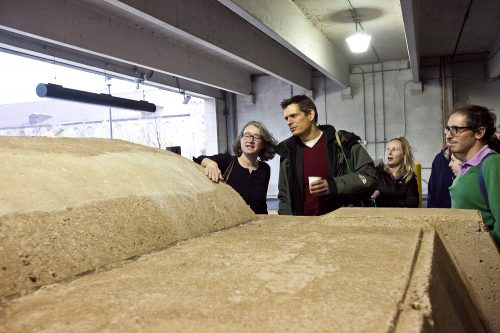
BY JUDY CARMACK BROSS
The most buzzworthy Chicago art resides not in one of our major museums but in the north campus parking lot of the University of Chicago.
Encased in concrete by German artist Wolf Vostell in 1970, the 32,400-pound Cadillac was the final destination of a celebratory “happening,” Chicago Fluxus, on January 22. Taking place at three University locations—the the Neubauer Collegium, the Special Collections Research Center, and the Smart Museum of Art—each destination featured fascinating exhibitions, with other Vostell concrete pieces displayed at the Smart.
The Fluxus artist’s movement of the 1960s championed performance art, and at each stop guests were encouraged to express themselves joyfully—whether it was to “laugh heartily” or to sing “Happy Birthday to You” to the concrete Cadillac, 47 years old that day. A trolley ferried participants to each location, and film projections from the trolley shone the spotlight on the University.
Thanks to the determination of Christine Mehring, Professor of Art at the University of Chicago, the concrete car is a happy resident at the U of C after five years of researching, fundraising, and advocating.
Mehring also curated Vestell Concrete, 1969-1973 featuring works done during and after the artist made the car. Guests may currently watch films describing its history while viewing the car in the parking lot.
We asked Mehring, a specialist on post-war German art, what people say when they see Concrete Traffic:
“I often hear everything from ‘Oh, that’s what that is?’ and ‘How the heck did you do that?’ to ‘It totally belongs in a garage!’ Regarding the current exhibit, I also hear a range of comments: ‘The exhibition really gives an entire set of new contexts to the sculpture, and I like it more now’—which is exactly what I hoped would happen—to ‘Wow, I cannot believe that concrete sticks out so far! How does it stay on?’ (exactly my own surprise when I first saw the works).”
Mehring, whom a member of her visiting committee describes as a person of deep professional competence with sparkling intellect and good humor, recently related her thoughts on her first encounter with the Cadillac:
“I have never felt such a rush of excitement as when I first saw Vostell’s Concrete Traffic, which at the time was in an industrial wasteland on Chicago’s west side. There was this vintage Cadillac, encased in a massive shell of concrete. It was a dream come true and I felt a responsibility to save it.”
Now part of the University of Chicago’s Campus Art Collection, it beckons art and car lovers alike to touch the car and look underneath. Its arrival on campus was celebrated by a parade featuring the car on a flatbed truck, accompanied by other vintage Caddys, through 20 miles of Chicago streets in September. Over 300 guests celebrated the car at a party October 14. Here’s how it all began:
“I was appointed to the University’s campus planning committee, which talked about our architectural landscape and the potential of public art. I was familiar with Vostell’s work and overwhelmed by the opportunity to save the car and bring it to campus. It became an intensive collective effort, involving numerous experts including art historians, vintage car experts, archivists, historians, scholars, and current and former students. I am so appreciative that the University put such a huge amount of faith in me and my judgment.”
Mehring, whose work concentrates on more scholarly assignments, found herself learning the ins and outs of forklifts and even crawling under the car with a Cadillac expert to inspect a deteriorating muffler.
Commissioned by Chicago’s Museum of Contemporary Art in 1969, the concrete car resided in a parking lot at St. Clair and Ontario until the rental space expired. Before it went into storage, it sat on the Midway Plaisance, just outside the Midway Studios where many of Chicago’s finest artists worked. It was later stored in Humboldt Park.
Growing up in Germany, Mehring—daughter of a lawyer father and a mother who worked in a hospital—visited her first museum at the age of 14: “I went to see a friend in Berlin and had to entertain myself for two weeks. I went every day for two weeks to different museums and I was hooked.”
She describes Vostell as a “tireless promoter of his art” and a legendary street performer. Surely he would have loved the University’s event. As Christine relates:
“The Fluxus performances were the best parts of the exhibition opening at the Smart. One involved cleaning the concrete floor outside the Smart door—it was perfect. In another, performers pushed a piano against a wall. I had always thought of these performances as anti-art, but no, how wrong I was. They were musical to the core; what wonderful sounds.”
***
Vostell Concrete: 1969-73 will be up at the Smart Museum, 5550 South Greenwood, until June 11. Concrete Traffic will not be going anywhere.
For more information visit: smartmuseum.uchicago.edu.













